WHY SHOULD I VISIT MALAWI?
Here are our top five reasons why you should visit Malawi:
- Lake Malawi – also known as the lake of stars
- Majete Wildlife Reserve – home of the Big 5, and one of the major conservation success stories
- Liwonde National Park – another conservation success story
- Zomba Plateau – where you can explore the tea plantations, go for walks, and relax
- Nyika Plateau – offers many adventure activities
This country is also described as the warm heart of Africa. It has much to offer those who visit. This includes beautiful wildlife, culture, various opportunities for adventure, incredible scenery, and also the third-largest lake in Africa. Lake Malawi is often referred to as the “Calendar Lake”. This is because the lake is 365 miles when measured from top to bottom, and it is 52 miles when measured at its widest point. There are 12 main rivers that flow into the lake.
Some say Malawi is the most beautiful country in sub-Saharan Africa.
What is the Best Time to Visit Malawi?

Sunny day on Lake Malawi – clear water and a cyclid.
The best time to visit Malawi is May to October, which is the dry season. The highlands, namely the Nyika Plateau can get quite cold during this period, but the lowlands, including Lake Malawi are pleasant, warm and sunny. During the wet season, November to April, many tourist accommodation options closes from mid-January to mid-March. During these months, Malawi is lush and green, the most beautiful time to visit.
The general rule of thumb is that the low-lying areas are hot and humid while the highlands are milder, but still mostly warm at night.
For birders, the best time to visit is between November and April when the resident species are joined by the migrant species.
Which Places Should I Include in My Visit?
Lake Malawi, sometimes known as the Lake of Stars, is the highlight of this country. The Majete Wildlife Reserve is a conservation success story with stunning varied scenery. Liwonde is the only place in Malawi that you can see the Big 5. For the more adventurous, the Nyika Plateau offers a wide range of adventure activities, while the Zomba Plateau has fantastic scenery and is quite unique.
How Long Should I Visit Malawi for?
- For a short stay, four nights on Lake Malawi will give you a taste of heaven.
- For a seven-night stay, we would include Lake Malawi and Liwonde or Lake Malawi and Majete
- For a 14-night stay, you can include Lake Malawi, Liwonde, Majete, and Zomba or Nyika Plateaux.
What is the Weather Like in Malawi?
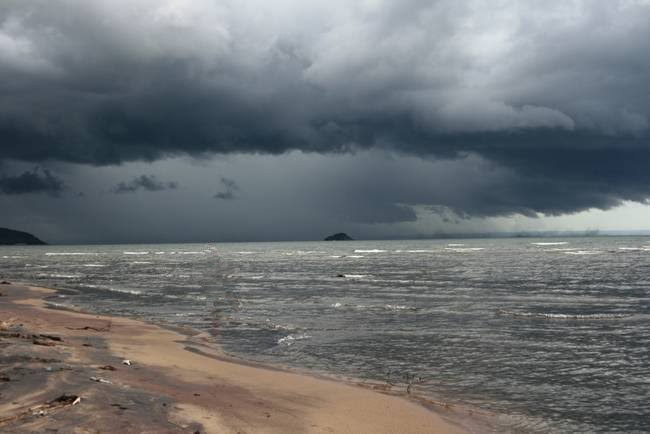
Rainy season on Lake Malawi
During the dry season, April to October, the chance of rain is slim, daytime temperatures are generally pleasant, and the low vegetation and limited availability of water mean that game viewing is at its best.
For birdwatching, the best season is during the rainy season, November to April, when the endemics are joined by the migratory birds. This is also the best time to see the orchids of the Nyika Plateau.
In the highlands, Zomba, Nyika, and Viphya, it can be quite cold at night. Because of its low altitude, the Lower Shire is the hottest part of Malawi, and is hot all-year-round.
Rainfall is extremely rare in the dry season, and even in the so-called wet season, the rains are usually short-lived storms, as is typical of the tropics. And at no time does the climate seriously inhibit the traveller. Around the country, rainfall varies, with the highlands causing the highest figures.

Malawi Climate Chart
Do I Need a Visa to Travel to Malawi?
Passport holders from most of the Commonwealth countries, USA, Japan, and the European Union do not require a visa to enter the country for tourism purposes. For those that need visas, a visa for the majority of nationalities can be obtained on arrival in Malawi. Be aware that the process at the ports of entry is currently time-consuming, so it is recommended that you obtain a visa beforehand, if possible.
What are the Health Requirements for Malawi?
Malawi is a malaria risk area. The lower lying regions, Shire Valley, Liwonde, Majete, and Lake Malawi are at a much higher risk than the highlands, Zomba, Nyika, and Viphya. Anti-malaria medication is recommended, and you should consult your doctor in this regard. To minimise the risk of contracting malaria, wear long trousers and cover your arms in the evening, and apply mosquito repellent.
Yellow fever vaccination is required if you are coming from an endemic country. The following vaccinations are recommended, but not compulsory:
- hepatitis A;
- typhoid;
- tetanus; and
- poliomyelitis.
If you are visiting rural Malawi or if you are taking part in trekking, we suggest vaccinations for:
- hepatitis B;
- rabies;
- meningococcal meningitis; and
- cholera vaccinations.
How Can I Travel Around in Malawi?
Self-driving is a good option if you want to experience Malawi. There are relatively short distances between places of interest; main roads are tarred, but narrow and are in a reasonable condition; and there is relatively little traffic. People and animals in the road can present a problem, as such, driving at night is discouraged.
There are domestic flights on Malawian Airlines between Lilongwe and Blantyre, as well as a couple of charter companies that service the various regions of Malawi. These flights are, however, not inexpensive.
There is a good network of public buses throughout the country, which are quite inexpensive. Mini-bus taxis offer short local journeys, while larger coaches are used for the longer distance routes. Taxis in Malawi are mainly found in the main cities, with fares usually being fairly low by international standards.
TOP TOURIST ATTRACTIONS
Lake Malawi
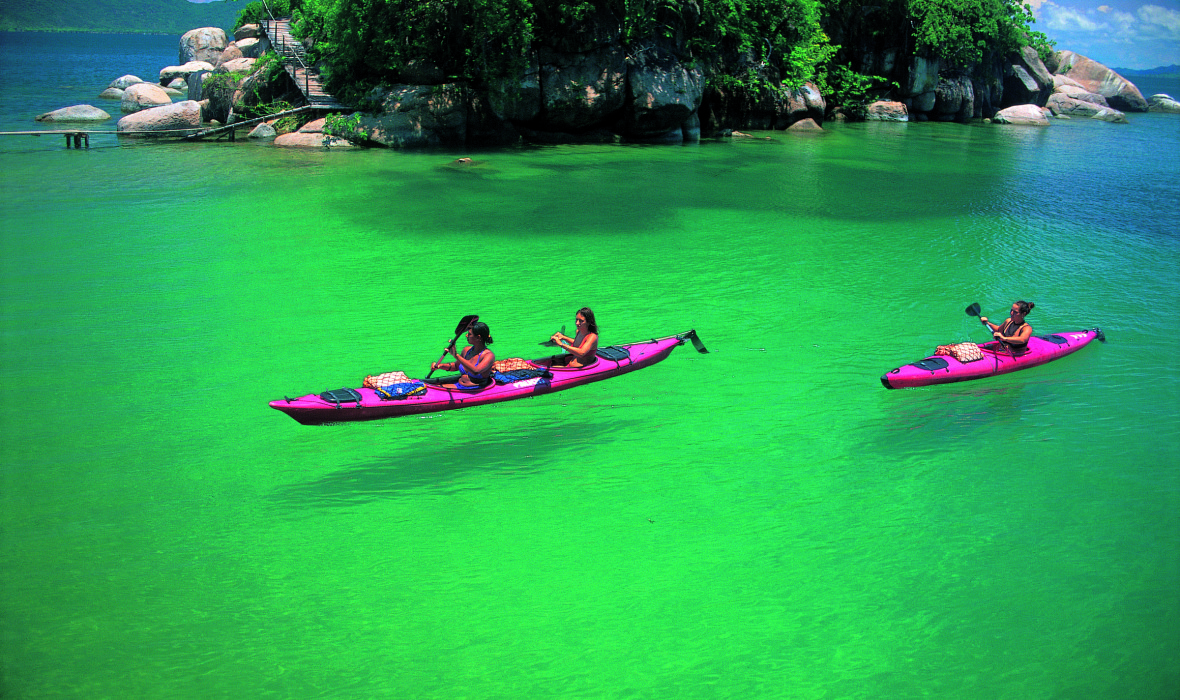
Kayak on Lake Malawi – courtesy of Kayak Africa
Lake Malawi was “discovered” by Dr David Livingstone about 150 years ago. It was he that named Lake Malawi “The Lake of Stars”. It was a reference to the way the light dances across the deep blue water during a sunny day and the stars that twinkle, combined with the lights of the local fishing vessels, at night.
Lake Malawi covers 30 000 km² and owes its formation to the forces that carved out the Great Rift Valley, eons ago. It is fed by 14 perennial rivers and flows out only into the Shire River, which in turn, feeds into the Zambezi River. The lake is ringed by beautiful sandy beaches and lush vegetation. The waters of the lake are home to over 1000 species of cichlid, not to mention thousands of other species, including Malawi eye biters and red zebras.
Fishing is a major contributor to the economy, and as a result, there are many fishing villages that are scattered along the lake’s shore.
Activities include sunbathing, swimming, kayaking, boating, fishing, walking, birdwatching, and visiting the local villages to experience the Malawian hospitality and way of life.
Majete Wildlife Reserve

Crossing the Mkulumadzi river on a walking safari – courtesy of Robin Pope Safaris
Only 70 km from Blantyre in south-west Malawi, in the Lower Shire Valley, the Majete Wildlife Reserve is just over three hours away from the closest section of Lake Malawi. The Majete at one time had an abundance of wildlife, but most of the larger game were killed off by the late 1990s.
In 2003, one of the largest relocations of wildlife ever begun. 14 species made up of 2559 animals were reintroduced. The process was concluded in March 2012, which included the reintroduction of black rhinos, lions, leopards, elephants, and Cape buffalos. Other species that were reintroduced included antelope such as sable, waterbuck, eland, hartebeest, nyala, impala, as well as zebra, warthog, and bush pig. As a result, Majete today is one of the only reserves that boast the Big 5.
Majete’s vegetation ranges from the Miombo woodlands in the West, dry savannah in the east, and riverine thickets along the rivers. Activities include game drives, walking safaris, boat trips to view game on the Shire River, and just relaxing. We also recommend that you do some hiking, as the park’s terrain is made for this, and visit the local villagers to experience their culture and tradition, including their tribal dances.
Liwonde National Park
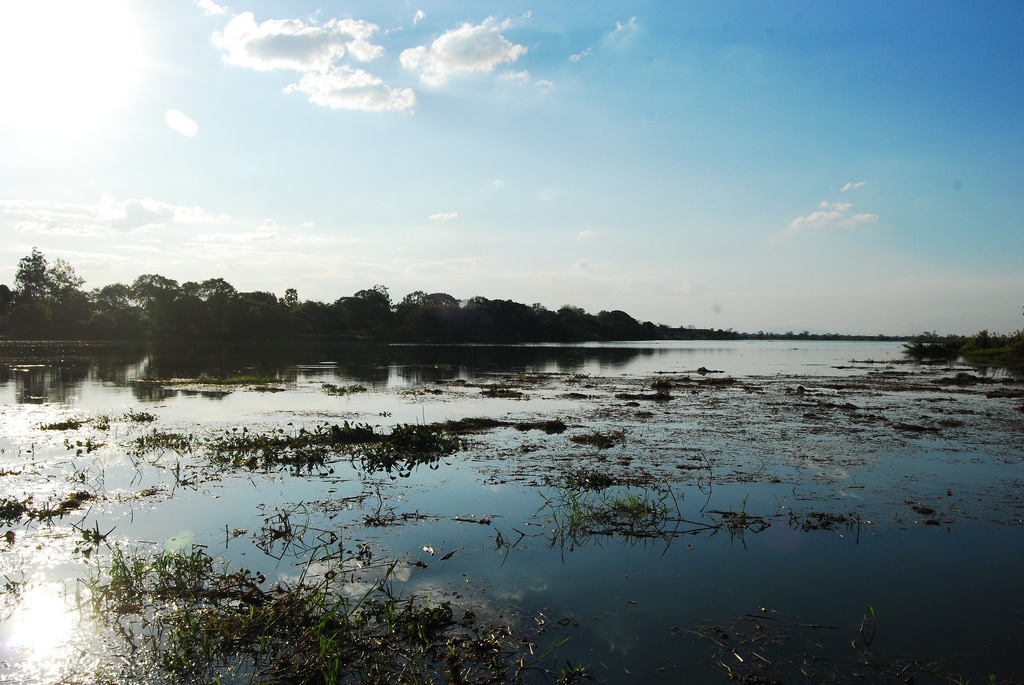
Shire River water way in Liwonde
Liwonde lies at the southern end of Lake Malawi and borders Lake Malombe. Its vegetation includes riverine swamps, deciduous woodlands in the low-lying areas, mopane woodlands on the higher regions, and open grassland. These diverse habitats result in some of the most scenic game viewing in Malawi. Liwonde reputedly has the best bird watching in Southern Africa.
Liwonde National Park was also the home of a massive wildlife translocation. The park was the victim of the highest level of human-wildlife conflict in the whole region. Testament to this were the tens of thousands of snares that needed to be removed. With more snares than animals, poaching in the park led to elephants and crocodiles retaliating by killing a number of people.
In partnership with the Department of National Parks and Wildlife (DNPW), African Parks started to manage Liwonde. The first order of business was to construct an electric fence. A year later, 336 elephants were relocated from Liwonde to the Nkhotakota Wildlife Reserve, one of the largest translocations ever. The result was to reduce the effects of overpopulation on the vegetation of Liwonde and to reduce the instances of human-wildlife conflict. During the process of bringing poaching under control, some 36000 snares have been removed since 2015.
Once the security of the park was reinstated, in 2017, Cheetahs were reintroduced into Liwonde, as well as a seed population of ten lions in 2018 both from both the Majete and from South Africa. This whole project has seen these populations thrive.
The Nyika Plateau

Oryx on the Nyika Plateau
The Nyika Plateau is found in a section of northern Malawi, and a small portion in north-eastern Zambia. The highest point is Nganda Peak at 2605 m, but the average elevation is between 2100 and 2200 m. It is roughly shaped like a diamond with its north-south axis measuring 90 km, and an east-west axis of 50 km. It towers above Lake Malawi (475 m), Livingstonia, and Chilumba. It is very different to other parts of Malawi, being a combination of rolling hills with streams, broad valleys, and rough grasslands with clumps of pine trees.
It is renowned for its wildlife, which species include Crawshay’s zebras, reed and bushbuck, roan antelope, eland, klipspringers, duikers, and warthogs. Jackals, hyenas, and leopards are also found in the area, but are rarely seen. It is also well-known for its endemic butterfly species, its birdlife, chameleons, frogs, and toads (Nyika dwarf toad), not to mention its splendid orchids. Nyika National Park protects the fauna and flora of the Nyika Plateau.
Zomba Plateau and Mount Mulanje
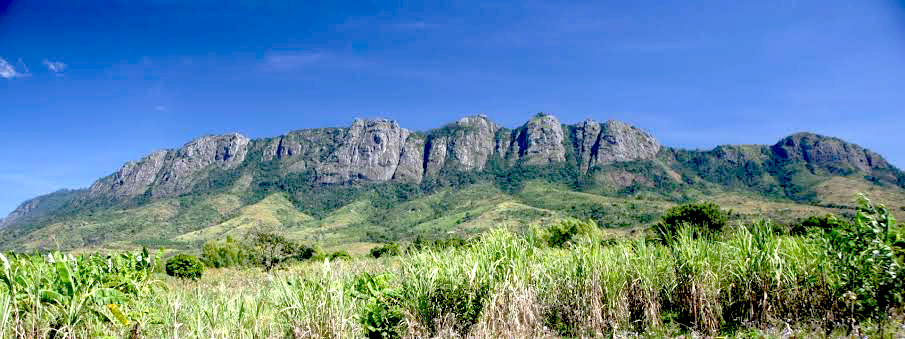
Zomba Massif
The Zomba Plateau is dominated by the Zomba Massif, which rises up to 2087 m. While the slopes are dotted with forests of cedar, pine, and cypress, the rest of the area is wild with a mixture of types of vegetation. The plateau has many streams, waterfalls, and lakes. If you have a 4×4 vehicle, there are navigable tracks right around the top with views that were described in colonial times as “the best in the British Empire”.
Other activities include walking trails, rock climbing, and hikes into the forest with a local guide. Horse riding and mountain biking round out an already impressive list.
A range of inselbergs, which include Mulanje, rise out of plains below. As a result of their elevation and shape, rainfall on the one side of the mountain is significantly different to the other. Almost four times more rain falls on top than on the south lower levels, and the rivers that start on the top feed in almost all of the southern parts of the country.
Mulanje’s lower levels are characterised by densely forested gorges and open grasslands. Different species of birds can be found in each, depending on their preferred habitat. The Mulanje Mountain Forest Reserve encompasses the whole mountain, and is home to butterflies, dwarf chameleon, a rare skink species and bird species, such as the white-winged apalis, Bertand’s weaver, buzzards, white-tailed crested flycatcher, and white-necked ravens. The endangered Mulanje cypress is found here.
We really recommend that you visit a tea plantation, found on the slopes of these mountains, to learn how they are grown, picked, and cured. The wildlife includes leopard, but sightings are rare; giant butterflies; and, on the lower slopes, baboons. Birdlife is quite prolific and includes the long-crested eagle and augur buzzard.
If you want to visit the warm heart of Africa, contact us at Q2 Travel to make your dreams come true.
GENERAL INFO AND HISTORY
Brief History
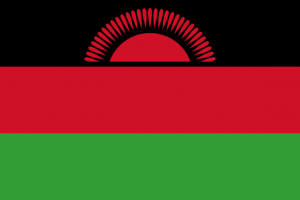
Malawi Flag
The Republic of Malawi was formerly known as Nyasaland. It is bordered by Zambia, Tanzania, and Mozambique. It was first colonised by tribes of Bantu who migrated to the area in the 10th century. By 1500, the Bantu became a large kingdom. In the 16th century they started to encounter Portuguese traders and military personnel with whom they began trading and making alliances. By the 17th century, the empire had broken back into individual tribes.
David Livingstone “discovered” Lake Malawi in 1859 and sent word that the area was suitable for settlement. Several Christian missions sprang up, and in 1889, a British protectorate was proclaimed over the Shire Highlands. In 1907, the protectorate was re-named Nyasaland, which remained its name until British rule ended in 1964. In 1964, Malawi gained its independence from Britain and became The Republic of Malawi.
The Malawi Congress Party came to power via elections in 1961 and Hastings Banda became Prime Minister in 1963. The new constitution was ratified in 1966, effectively making Malawi a one-party country. In 1970, Banda declared himself president for life. During his tenure or three decades, the country’s economy, agriculture, and industry developed impressively.
A referendum in 1993 resulted in Malawi becoming a multi-party democracy, with a new constitution and no presidency for life. The country is essentially pro-western and is part of the Commonwealth.
Economy and Health
Malawi is one of the world’s least developed countries and relies heavily on foreign aid. As a predominantly agricultural economy, which is fickle at the best of times, falling international aid has left Malawi facing huge challenges.
The people of Malawi generally have a low life expectancy, face high infant mortality rates, and have a high infection rate of HIV/AIDS. The population is diverse, with people speaking different languages and practising different religions.
Money
The unit of currency used in Malawi is the Malawi Kwacha with coins called Tambala. The US dollar is widely accepted at tourist establishments, but for buying local goods, it is good to have the local currency. You will receive change from the locals only in the local currency.
Contact Q2 Travel for more information and if you are interested in visiting this beautiful country. A world of adventure awaits when you make Malawi your destination of choice.
Contact Us & Sitemap
Latest Articles
- African Safari Tours – Part 4 – Big 3 African Transfrontier ParksDecember 9, 2019 - 7:57 am
 African Safari Tours – Part 3 – Zimbabwe’s trio of safari must dos.November 18, 2019 - 7:07 am
African Safari Tours – Part 3 – Zimbabwe’s trio of safari must dos.November 18, 2019 - 7:07 am African Safari Tours – Part 2 – Unique Animals of AfricaNovember 14, 2019 - 6:52 am
African Safari Tours – Part 2 – Unique Animals of AfricaNovember 14, 2019 - 6:52 am African Safari Tours – Part 1November 13, 2019 - 5:27 am
African Safari Tours – Part 1November 13, 2019 - 5:27 am African ToursSeptember 26, 2019 - 11:25 am
African ToursSeptember 26, 2019 - 11:25 am


